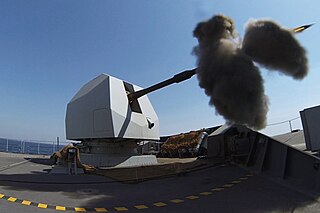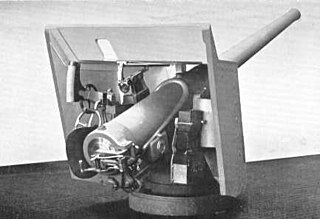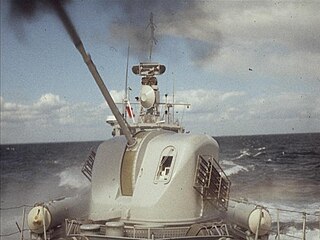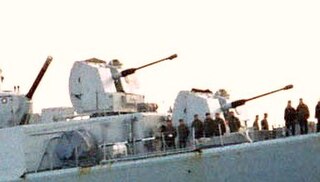
Modern French 100 mm naval guns are multipurpose artillery pieces, capable of a high rate of fire. Most modern French warships are/were equipped with one of its versions.

OTO Melara was a subsidiary of the Italian company Finmeccanica S.p.A., active in the defence sector, with factories in Brescia and La Spezia. The Mod 56 pack howitzer, in service throughout the world, and the 76mm naval gun, adopted by 53 navies and installed on over 1,000 naval vessels, are among OTO Melara's best-known weapons since World War II.

The OTO Melara 76 mm gun is a naval gun built and designed by the Italian defence company Oto Melara. It is based on the Oto Melara 76/62C and evolved toward 76/62 SR and 76/62 Strales.

A dual-purpose gun is a naval artillery mounting designed to engage both surface and air targets.

The 127 mm (5")/54 caliber lightweight gun is a U.S. naval artillery gun mount consisting of a 127 mm (5 in) L54 Mark 19 gun on the Mark 45 mount. It was designed and built by United Defense, a company later acquired by BAE Systems Land & Armaments, which continued manufacture.

The 3″/50 caliber gun in United States naval gun terminology indicates the gun fired a projectile 3 inches (76 mm) in diameter, and the barrel was 50 calibers long. Different guns of this caliber were used by the U.S. Navy and U.S. Coast Guard from 1890 through the 1990s on a variety of combatant and transport ship classes.

The 4.5 inch Mark 8 is a British naval gun system which currently equips the Royal Navy's destroyers and frigates, and some British destroyers and frigates sold to other countries.

The three Chester-class cruisers were the first United States Navy vessels to be designed and designated as fast "scout cruisers" for fleet reconnaissance. They had high speed but little armor or armament. They were authorized in January 1904, ordered in fiscal year 1905, and completed in 1908. In 1920 all scout cruisers were redesignated as "light cruisers" (CL).
The Type 210 automatic single 100 mm naval gun is the Chinese modification of the Compact model of the French 100 mm naval gun. There are at least two variants, with both sharing similar characteristics with the French weapon.

The Otobreda 127mm/54 Compact (127/54C) gun is a dual purpose naval artillery piece built by the Italian company Oto Melara. It uses the 127mm round which is also used in the 5 inch/ 54 gun, albeit that this gun calibre is measured in United States customary units rather than metric. The gun uses an automatic loading system where 66 127mm rounds of various kinds can be stored ready-to-fire in three loader drums. The barrel is water-cooled. Currently the gun is still in use by navies around the world but it is slowly being replaced by the Otobreda 127/64 for new vessels, such as the German Navy's F125-class frigate and Italian Navy's FREMM.

The QF 4.7-inch Gun Mks I, II, III, and IV were a family of British quick-firing 4.724-inch (120 mm) naval and coast defence guns of the late 1880s and 1890s that served with the navies of various countries. They were also mounted on various wheeled carriages to provide the British Army with a long range gun. They all had a barrel of 40 calibres length.

The Bofors 57 mm l/70 naval guns are a series of dual-purpose naval guns designed and produced by the Swedish arms manufacturer AB Bofors, designed in 1964 as a revision of the 57 mm lvakan M/50 used on the Halland-class destroyers. Production of the baseline 57 mm Mark 1 variant began in 1966 and was initially used to equip smaller coastal patrol craft and fast attack craft. The gun is remotely controlled by a fire-control computer; as a redundancy measure, however, the crew can also operate the gun using instrument panels that are either on or in direct contact with the gun. Although the Swedish Navy is the primary user of the gun, it has been exported widely by Bofors Defence for use by the navies of Brunei, Canada, Croatia, Finland, Indonesia, Ireland, Malaysia, Mexico, Montenegro, Singapore, Thailand and the United States.

The 6"/47 caliber Mark 16 gun was used in the main batteries of several pre-war and World War II US Navy light cruisers. They were primarily mounted in triple turrets and used against surface targets. The 6"/47 caliber Mark 16DP gun was a dual purpose fitting of the Mark 16 for use against aircraft as well as surface ships. It was installed in the post-war Worcester-class light cruisers and the anti-aircraft gunnery training ship Mississippi.

The Mark 42 5"/54 caliber gun (127mm) is a naval gun mount used by the United States Navy and other countries. It consisted of the Mark 18 gun and Mark 42 gun mount. United States naval gun terminology indicates the gun fires a projectile 5 inches (127.0 mm) in diameter, and the barrel is 54 calibers long In the 1950s a gun with more range and a faster rate of fire than the 5"/38 caliber gun used in World War II was needed, therefore, the gun was created concurrently with the 3"/70 Mark 26 gun for different usages. The 5"/54 Mk 42 is an automatic, dual-purpose gun mount. It is usually controlled remotely from the Mk 68 Gun Fire Control System, or locally from the mount at the One Man Control (OMC) station.

The 4"/50 caliber gun was the standard low-angle, quick-firing gun for United States, first appearing on the monitor Arkansas and then used on "Flush Deck" destroyers through World War I and the 1920s. It was also the standard deck gun on S-class submarines, and was used to rearm numerous submarines built with 3-inch (76 mm) guns early in World War II. United States naval gun terminology indicates the gun fired a projectile 4-inch (102 mm) in diameter, and the barrel was 50 calibers long.

The 5"/25 caliber gun entered service as the standard heavy anti-aircraft (AA) gun for United States Washington Naval Treaty cruisers commissioned in the 1920s and 1930s. The goal of the 5"/25 design was to produce a heavy AA gun that was light enough to be rapidly trained manually. The gun was also mounted on pre-World War II battleships and aircraft carriers until replaced by the standard dual-purpose 5"/38 caliber gun, which was derived from the 5"/25 and was similar except for the barrel length. Guns removed from battleships were probably converted for submarine use by late 1943, while a purpose-built variant for submarines was available in mid-1944, and was widely used by them. United States naval gun terminology indicates the gun fired a projectile 5 inches (127 mm) in diameter, and the barrel was 25 calibers long.

The Oto Melara 127/64 Lightweight (LW) naval gun mount is a rapid fire gun mount suitable for installation on large and medium size ships,it also has a version for coastal defense, intended for surface fire and naval gunfire support as main role and anti-aircraft fire as secondary role. The compactness of the gun feeding system makes possible the installation on narrow section crafts.

The 76mm/L62 Allargato is a single barrel, medium caliber, dual purpose automatic naval cannon designed and produced in the 1960s by the Italian defence firm of OTO-Melara as the cannon armament for all medium and large class warships built for the Italian Navy in that decade. Currently, the gun remains in service with Italy's Cassiopea class patrol vessels but has otherwise been largely replaced by the Otobreda 76 mm series of cannons.

The AK-130 is an automatic naval cannon with a caliber of 130 millimetres (5.1 in).

















